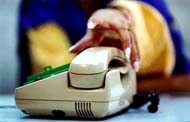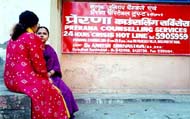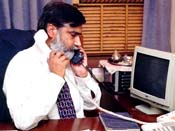A Hotline to Help!
Chindu Sreedharan in Bombay
 There! There it goes again!
There! There it goes again!
This was the eighth time the phone was ringing in the one hour he had been waiting outside. He was sure; he had counted it.
Seated here, out on the verandah of the counselling centre Prerana -- a charitable organisation -- on one of those plastic chairs which he hated so much, he could see the notices on the opposite wall. 'Think Before You Think Of Suicide,' screamed one in bold black. 'It's A Myth That People Who Talk Suicide Won't Do It' announced another while a third, more subdued than the others, revealed more about suicide -- that it increases with age, that it is the fourth common cause of death in the 15 to 34 age group, that 50 per cent more males succeed in their attempts than females...
There were also a couple of newspaper clippings about Prerana's Round The Clock Suicide Prevention Hotline which, since its inception on July 20,1996, had attracted over 4,000 crisis calls.
 The phone had stopped ringing now -- counsellor Veena Iyer must have interrupted her session to answer it. She would now be listening intently to the distress call, occasionally scribbling a note on the register before her and probing in that soothing voice of hers to assess the nature of the crisis. She would be encouraging the caller to 'ventilate' his feelings and looking for those telltale 'symptoms which signals psychiatric disorders... '
The phone had stopped ringing now -- counsellor Veena Iyer must have interrupted her session to answer it. She would now be listening intently to the distress call, occasionally scribbling a note on the register before her and probing in that soothing voice of hers to assess the nature of the crisis. She would be encouraging the caller to 'ventilate' his feelings and looking for those telltale 'symptoms which signals psychiatric disorders... '
He wished the counsellor would finish her session soon; he too needed to talk to her. Not that he was planning suicide or anything. Gosh, no! But he wanted to talk, he needed more information.
Inside, Veena had finished answering the phone -- it wasn't a suicide-related call, but a student who had the usual pre-exams jitters -- and was back with the fair, jean-clad young man who had knocked on the door earlier.
''Gopa?" he had asked, ''I am ----. I was asked to come...''
''No, Gopa isn't here. But you can talk to me," she had told him, waving him into a chair.
She remembered the case well. The boy -- he was no more than a boy -- was the seventh person to call that morning. He was a medical internee who was feeling extremely suicidal. He confessed he had even prepared a noose. The line had at this point got disconnected, but he had called up in a few minutes again. Gopa, the other counsellor, had answered and persuaded him to come down to the centre.
So here he was now. Veena could see that all the major risk factors that makes a potential victim were there. Fortunately, the boy realised he needed medical help. He wanted to get better, the motivation was there. That was one point in his favour. Usually, such patients never realised they had a problem; that it was not normal to want to end their life.
 The boy was far too depressed to give up his intentions with mere counselling; he needed skilled psychiatric help immediately. That was obvious. She suggested it to him, found him
receptive to the idea, and fixed an appointment with Dr Amresh Shrivastava, Prerana's project director. ''And remember, you are free to call us anytime," she said as the boy picked up his bag and prepared to leave. He nodded and went out, closing the door gently behind him. (Two days later the boy was to call up again and get himself admitted.)
The boy was far too depressed to give up his intentions with mere counselling; he needed skilled psychiatric help immediately. That was obvious. She suggested it to him, found him
receptive to the idea, and fixed an appointment with Dr Amresh Shrivastava, Prerana's project director. ''And remember, you are free to call us anytime," she said as the boy picked up his bag and prepared to leave. He nodded and went out, closing the door gently behind him. (Two days later the boy was to call up again and get himself admitted.)
There was a knock on the door and the man who had been waiting outside walked in. ''Sorry to keep you waiting for so long," Veena said, ''What would you like to know about the hotline?''
'''Well, on any day between 10 am and 6 pm the number wouldn't be less than 30. And that's not counting the prank calls," she begins, ''But I think you would better wait for Dr Shrivastava. He will be able to give you the statistics."
So they waited. While more calls poured in.
The nattily dressed gentleman who rushed in without knocking and pounced on the call-register immediately was -- but, of course! -- Dr Shrivastava.
''How many calls did we have today?" he asks briskly.
Obviously, the good doctor was in a great hurry. A practising psychiatrist and a member of the International Association of Suicide Prevention and the World Federation of Mental Health, Dr Shrivastava is also the secretary general of the 1992-formed Indian Association of Suicidology.
 ''We had been planning to set up a hotline service since 1984,'' Dr Shrivastava says, ''It is a serious handicap not having such a service in a metropolis like Bombay. Especially with the number of suicides going up every year,'' he says.
''We had been planning to set up a hotline service since 1984,'' Dr Shrivastava says, ''It is a serious handicap not having such a service in a metropolis like Bombay. Especially with the number of suicides going up every year,'' he says.
The number of suicides in the country had been climbing steadily since the eighties -- from 40,245 in 1981 it touched 84,244 by 1993. The 1995 figures show that it has further climbed to over 94,000 suicides. In Bombay alone (which has the third largest suicide rate in the country -- Madras tops the chart with Bangalore close behind), over 12,000 people take the easy way out every year.
''This is just the recorded number," says Dr Shrivastava, ''The actual figures would be much, much higher than this -- maybe 10 times as many!" And as for the number of attempted suicides, it is even more difficult to compute. But experts believe that there has been at least a 9.2 fold increase in the last decade.
''About 50 per cent of these cases try again and ultimately 10 per cent succeed in the act," he adds. ''Most of these incidents can be prevented if proper psychiatric care is provided."
The first six months had seen the centre handling a total of 1,892 calls, around 25 to 30 calls every day. While 86 per cent of the callers belonged to the 20 to 40 age group, the above-40 group accounted for another 22 per cent. The rest were youngsters below 20 years of age. Of this, 207 patients were with suicide ideation.
''Generally, it is in the 18 to 25 and the above-55 age group that suicide ideation is more common,'' says Dr Shrivastava. ''While it is employment, career and biological turmoil that drives the youth to suicides, in the advanced age it is job frustration and family problems that are the major causes.''
The number of calls, however, has shot up in the last two months -- over 3,000 calls have been registered during the period. ''Now with the secondary examinations on, the callers are mostly students with the usual pre-exam jitters,'' says Dr Shrivastava. And with the line constantly clogged with such calls, genuine crisis calls are far and few in between.
What about prank calls? The centre must surely be getting its share.
''Sure, we do get many.'' It was Veena who answered. ''But fortunately, the number has come down. In any case, we can't afford to put off a call as prank however sure we are about it. Every call has to be handled as genuine.''
Meditation may be the magic mantra to combat fear and stress in India's schools
Photographs: Jewella Miranda
|





